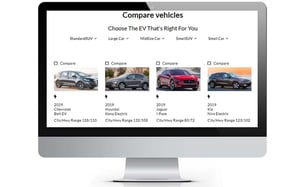This article originally posted on Energy Central. Click here to read the Energy Central article.
Imagine with me for a second. You’re scrolling down your favorite news site when you see a sidebar ad for an amazing shirt that’ll be perfect for the summer rafting trip you just booked. And it’s on sale! So, you click the photo of the ad with the intention of making a quick purchase. But when the web page finally loads, it’s not a product detail page on an e-commerce site; it’s a webpage with a lot of words and a form to sign up to have someone come to your house and talk to you about it, so you can buy that cool shirt directly from them. They’ll even help you try it on! And they’ll have a conversation with you at your kitchen table about all the places you can wear it.
Now, you may also need to fill out some rebate paperwork – but only if you want that discount you saw in the ad. Don’t worry, it’ll be a fillable PDF and you’ll get a check in 8 weeks. And did I mention they have to call you back and play phone tag for a few days before you can even get the appointment scheduled? You give up, of course. Because rafting trip or not, no shirt is cool enough to justify that level of hassle.
And yet, we play out this ludicrous scenario in utility programs all over the country, all day long. The only difference is we’re hawking smart thermostats and HVAC equipment instead of cool shirts you can wear rafting. With so many hurdles along the way, it’s no wonder we have trouble getting people to participate. Shoppers want their experiences to be quick, easy, and friction-free. So, how can utilities meet these needs?
E-commerce is nothing new to utilities.
 By now, most have realized that it has become a required offering to incorporate into today’s utility programs; this means including a variety of easy-to-install, readily available products with instant rebates and free shipping in utility-based marketplaces. According to Guidehouse, global utility marketplace revenue is anticipated to grow from just over $188 million in 2020 to $468 million by 2029. It’s safe to say that the online marketplace has become a well-accepted trend across the industry.
By now, most have realized that it has become a required offering to incorporate into today’s utility programs; this means including a variety of easy-to-install, readily available products with instant rebates and free shipping in utility-based marketplaces. According to Guidehouse, global utility marketplace revenue is anticipated to grow from just over $188 million in 2020 to $468 million by 2029. It’s safe to say that the online marketplace has become a well-accepted trend across the industry.
But we’re still making it way too hard to learn about more complicated products like EV chargers, stack rebates from various EE and DR programs, get financing for big ticket items like heat pumps, and coordinate installation for larger projects like weatherization. And we’re not really connecting the online and offline worlds into a seamless experience for rebates. Or seamlessly segmenting customers behind the scenes to show them the bigger rebates they qualify for—if they’re low-income, for example.
Next Level Utility Customer Experience
In a recent study by Jaywing, 73% of utility marketers ranked “improving the digital customer contact strategy” as a top priority. By leveraging an integrated marketplace, utilities can go beyond keeping up with Amazon and the expectation it creates for customers. They can provide an entirely new, comprehensive approach to program participation that offers all the benefits of online shopping and none of the clunkiness our industry has become known for. An approach so tailored, in fact, that our user testing found customers were more likely to invest in a larger purchase on their utility’s integrated marketplace than elsewhere online. And they made these big-ticket purchasing decisions shockingly fast. Let’s dig into what makes it work.
 An integrated marketplace offers the standard fare of online product purchasing—but it goes a step further by promoting entire projects that wouldn’t typically be feasible for a marketplace, and it integrates cross-selling and upselling throughout. For example, a customer can easily identify the right water heater for their needs and purchase the entire project (complete with stacked instant rebates, enrollment in DR, financing and installation) in a single transaction. Then during checkout, we can upsell them on hot water-saving showerheads and aerators, and the following week during a smart thermostat promotion, we can cross-sell to an already interested audience. Typically a large-scale investment, Franklin Energy has found that customers are far more likely to invest a large amount of money into a project that has been specifically recommended by their utility, especially when it’s tailored to their own needs and the entire process is made easy and affordable. In this way, utilities can leverage the trust they have built with their customers—alongside personalized outreach and offers tailored from enriched data and propensity models—to make accurate and timely project recommendations.
An integrated marketplace offers the standard fare of online product purchasing—but it goes a step further by promoting entire projects that wouldn’t typically be feasible for a marketplace, and it integrates cross-selling and upselling throughout. For example, a customer can easily identify the right water heater for their needs and purchase the entire project (complete with stacked instant rebates, enrollment in DR, financing and installation) in a single transaction. Then during checkout, we can upsell them on hot water-saving showerheads and aerators, and the following week during a smart thermostat promotion, we can cross-sell to an already interested audience. Typically a large-scale investment, Franklin Energy has found that customers are far more likely to invest a large amount of money into a project that has been specifically recommended by their utility, especially when it’s tailored to their own needs and the entire process is made easy and affordable. In this way, utilities can leverage the trust they have built with their customers—alongside personalized outreach and offers tailored from enriched data and propensity models—to make accurate and timely project recommendations.
Making Online Shopping and Rebates Easy
 But like I said, an integrated marketplace is all about going above and beyond to meet the customer where they’re comfortable. Maybe they want to buy that water heater through their trusted plumber friend Peter or at their local Lowes. Maybe it makes more sense to buy their EV charger when they’re at the GM dealership picking out their new Hummer EV. An integrated marketplace can make those offline rebate channels just as easy as online. It’s a truly hassle-free approach to projects, with the customer at the center of the experience, and the utility reaping the benefits.
But like I said, an integrated marketplace is all about going above and beyond to meet the customer where they’re comfortable. Maybe they want to buy that water heater through their trusted plumber friend Peter or at their local Lowes. Maybe it makes more sense to buy their EV charger when they’re at the GM dealership picking out their new Hummer EV. An integrated marketplace can make those offline rebate channels just as easy as online. It’s a truly hassle-free approach to projects, with the customer at the center of the experience, and the utility reaping the benefits.
With a platform as robust as the integrated marketplace, utilities are not poised to compete with Amazon but instead to perform in a class all their own. By removing as many barriers to customer engagement as possible, and leveraging the lucrative incentives utilities already offer, an integrated marketplace is the utility’s ideal tool to promote product sales, program enrollment, energy savings, electrification and more. It establishes trust and builds a positive relationship with customers who already see their utility as an authority on energy. To return to the metaphor of purchasing the shirt, an integrated marketplace isn’t just the place to buy a shirt for your rafting trip—it’s also the place to research and book the entire excursion. What could be simpler than that?





